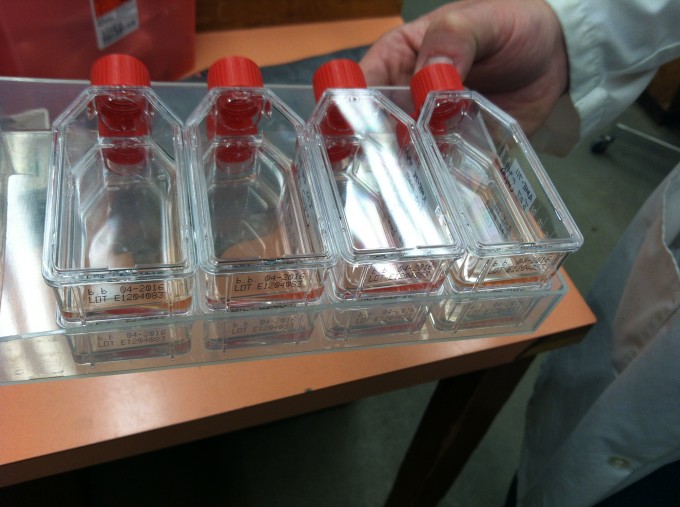Cell cultures are cells that are removed from an organism and grown apart from the body in a controlled environment. Put another way, cells in a cell culture are living and reproducing, but are grown in a lab instead of as a part of a body. Cell lines are cell cultures that come from the same genetic background, meaning all cells grown from a cell line are from the same set of original cells. Cell cultures are grown in a controlled environment, allowing researchers to conduct highly controlled studies where cells can be exposed to different factors and the response of the cells is measured. Cell cultures have been instrumental to advances in medicine, including better understanding the effects cancer, viruses, toxins, genes, radiation, nutrition, and developing vaccines.
Until recently, there was no cell line for honey bees. Michael Goblirsch, a PhD student at the University of Minnesota bee lab, was the first person able to establish a growing line of honey bee cells, which he named AME – 711, an acronym for “Apis melliferea Embryos” and 711 refers to July 11, 2013 when the cell line was started. To get cells to start a line, Mike removed eggs from honey bee colonies, washed and sterilized the eggs, mashed them up to beak up the eggs, and then put the egg-mash into a small plastic bottle with a medium that provided the cells with food and a place to grow. Cells in one of the 100 or so cultures he started actually started reproducing and has continued to grow.
Mike has had many requests for his AME-711 honey bee cell line from researchers interested in investigating effects of pathogens or pesticides on honey bee cells. Mike himself has infected cells from his line with Nosema to look at what happens to the cells and the Nosema organism.
In humans, the oldest and most commonly used cell line is the HeLa line, named after Henrietta Lacks. Researchers were unsuccessful in finding a line of human cells that would survive and reproduce outside the body before they took a sample of cells from Ms. Lack’s cervical cancer. Her cells were taken in 1951; around the time there was a race to come up with a vaccine for Polio. Scientists infected HeLa cells with the Poliovirus to replicate the virus into large enough numbers to test different vaccines, which allowed Jonas Salk to come up with a Polio vaccine. HeLa cells have been used in many, many research studies. Rebecca Skloot, author of The Immortal Life of Henrietta Lacks, estimated that in 2009 the number of published papers about research done on HeLa cells was over 60,000.
With access to a cell line, a new door into honey bee research has been opened and there is huge potential for developments that can help us better understand why bees are dying.
You can read Mike’s published article HERE. If you are interested in hearing more about the HeLa line, you can read Rebecca Skloot’s The Immortal Life of Henrietta Lacks or listen to a recent Radiolab podcast (the HeLa story starts about 35:30).

